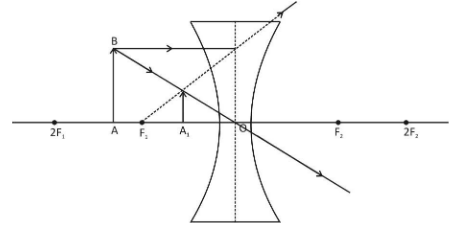
Lens formula is given by _ _ _ _ _ _ _ _
Answer
568.5k+ views
Hint: In this question, we need to establish the Lens formula. For this we will use the relation between image distance, object distance, and focal length in case of either convex or concave lens.
Complete step by step answer:
Let AB represent an object placed at right angles to the principal axis at a distance greater than the focal length (f) of the convex lens. The image A1B1 is formed between O and F1 on the same side as the object is kept, and the image is erect and virtual.

By sign conventions, all distances are given by
OF1$ = $focal length$ = f$
OA$ = $object distance$ = u$
OA1$= v$
Now, $\Delta OAB\,and\,\Delta OAB,\,$are similar [because $\angle BAO = \angle BAO = 90^\circ ,$vertex O is common for both the triangles so $\angle AOB = \angle ABO$ So, $\angle ABO = \angle ABO$ are similar]
From similarity criteria, we have
$\Rightarrow\dfrac{{{A_1}}}{{AB}} = \dfrac{{O{A_1}}}{{OA}}......(i)$
Similarly, $\Delta OCF$and$\Delta FAB$are also similar
So,$\dfrac{{{A_1}{B_1}}}{{OC}} = \dfrac{{{A_1}{F_1}}}{{O{F_1}}}.....(ii)$
But from the ray diagram, we see
So, equation (ii) becomes
$
\Rightarrow\dfrac{{{A_1}{B_1}}}{{AB}} = \dfrac{{{A_1}{F_1}}}{{O{F_1}}} = \dfrac{{O{F_1} - O{A_1}}}{{O{F_1}}} \\
\Rightarrow\dfrac{{{A_1}{B_1}}}{{AB}} = \dfrac{{O{F_1} - O{A_1}}}{{O{F_1}}}.....(iii) \\
$
From equation (i) and equation (iii), we get
$\Rightarrow\dfrac{{O{A_1}}}{{OA}} = \dfrac{{O{F_1} - O{A_1}}}{{O{F_1}}}$
By sign conventions,
$
\Rightarrow O{A_1} = - v \\
\Rightarrow OA = - u \\
\Rightarrow O{F_1} = - f \\
$
So, we have
\[
\Rightarrow \dfrac{{ - v}}{{ - u}} = \dfrac{{ - f - ( - v)}}{{ - f}} \\
\Rightarrow \dfrac{v}{u} = \dfrac{{ - f + v}}{{ - f}} \\
\Rightarrow - vf = - uf + uv \\
\]
Dividing both sides by uvf
$
\Rightarrow\dfrac{{ - vf}}{{uvf}} = \dfrac{{ - uf}}{{uvf}} + \dfrac{{uv}}{{uvf}} \\
\Rightarrow \dfrac{{ - 1}}{u} = \dfrac{{ - 1}}{v} + \dfrac{1}{f} \\
\Rightarrow \dfrac{1}{f} = \dfrac{1}{v} = \dfrac{1}{u} \\
$
Hence, the required formula for the lens is given as $\dfrac{1}{f} = \dfrac{1}{v} = \dfrac{1}{u}$.
Note:Before finding the lens formula, we must remember the sign convention for the lens, which is
(i) All distances are to be measured from the optical center of the lens.
(ii) Distances measured in the direction of incident ray (which is from left to right) are taken as positive.
(iii) Distances measured in the direction opposite to incident ray are taken as negative.
(vi) Height measured upward; the principal axis is taken as positive.
(v) Height measured downward; the principal axis is taken as negative.
Complete step by step answer:
Let AB represent an object placed at right angles to the principal axis at a distance greater than the focal length (f) of the convex lens. The image A1B1 is formed between O and F1 on the same side as the object is kept, and the image is erect and virtual.

By sign conventions, all distances are given by
OF1$ = $focal length$ = f$
OA$ = $object distance$ = u$
OA1$= v$
Now, $\Delta OAB\,and\,\Delta OAB,\,$are similar [because $\angle BAO = \angle BAO = 90^\circ ,$vertex O is common for both the triangles so $\angle AOB = \angle ABO$ So, $\angle ABO = \angle ABO$ are similar]
From similarity criteria, we have
$\Rightarrow\dfrac{{{A_1}}}{{AB}} = \dfrac{{O{A_1}}}{{OA}}......(i)$
Similarly, $\Delta OCF$and$\Delta FAB$are also similar
So,$\dfrac{{{A_1}{B_1}}}{{OC}} = \dfrac{{{A_1}{F_1}}}{{O{F_1}}}.....(ii)$
But from the ray diagram, we see
So, equation (ii) becomes
$
\Rightarrow\dfrac{{{A_1}{B_1}}}{{AB}} = \dfrac{{{A_1}{F_1}}}{{O{F_1}}} = \dfrac{{O{F_1} - O{A_1}}}{{O{F_1}}} \\
\Rightarrow\dfrac{{{A_1}{B_1}}}{{AB}} = \dfrac{{O{F_1} - O{A_1}}}{{O{F_1}}}.....(iii) \\
$
From equation (i) and equation (iii), we get
$\Rightarrow\dfrac{{O{A_1}}}{{OA}} = \dfrac{{O{F_1} - O{A_1}}}{{O{F_1}}}$
By sign conventions,
$
\Rightarrow O{A_1} = - v \\
\Rightarrow OA = - u \\
\Rightarrow O{F_1} = - f \\
$
So, we have
\[
\Rightarrow \dfrac{{ - v}}{{ - u}} = \dfrac{{ - f - ( - v)}}{{ - f}} \\
\Rightarrow \dfrac{v}{u} = \dfrac{{ - f + v}}{{ - f}} \\
\Rightarrow - vf = - uf + uv \\
\]
Dividing both sides by uvf
$
\Rightarrow\dfrac{{ - vf}}{{uvf}} = \dfrac{{ - uf}}{{uvf}} + \dfrac{{uv}}{{uvf}} \\
\Rightarrow \dfrac{{ - 1}}{u} = \dfrac{{ - 1}}{v} + \dfrac{1}{f} \\
\Rightarrow \dfrac{1}{f} = \dfrac{1}{v} = \dfrac{1}{u} \\
$
Hence, the required formula for the lens is given as $\dfrac{1}{f} = \dfrac{1}{v} = \dfrac{1}{u}$.
Note:Before finding the lens formula, we must remember the sign convention for the lens, which is
(i) All distances are to be measured from the optical center of the lens.
(ii) Distances measured in the direction of incident ray (which is from left to right) are taken as positive.
(iii) Distances measured in the direction opposite to incident ray are taken as negative.
(vi) Height measured upward; the principal axis is taken as positive.
(v) Height measured downward; the principal axis is taken as negative.
Recently Updated Pages
Master Class 12 Economics: Engaging Questions & Answers for Success

Master Class 12 Maths: Engaging Questions & Answers for Success

Master Class 12 Biology: Engaging Questions & Answers for Success

Master Class 12 Physics: Engaging Questions & Answers for Success

Basicity of sulphurous acid and sulphuric acid are

Master Class 12 Business Studies: Engaging Questions & Answers for Success

Trending doubts
What are the major means of transport Explain each class 12 social science CBSE

Which are the Top 10 Largest Countries of the World?

Draw a labelled sketch of the human eye class 12 physics CBSE

How much time does it take to bleed after eating p class 12 biology CBSE

Explain sex determination in humans with line diag class 12 biology CBSE

Differentiate between homogeneous and heterogeneous class 12 chemistry CBSE




